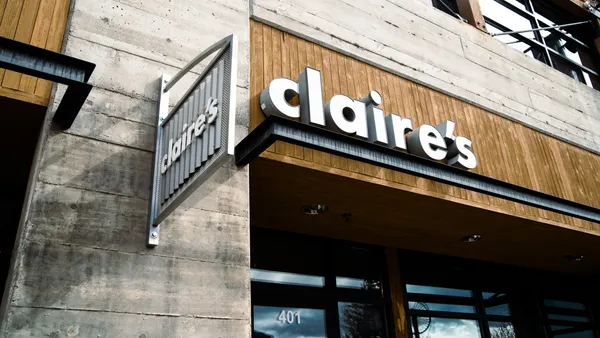UPDATE: February 25, 2021: Belk has emerged from Chapter 11 bankruptcy a day after filing, the company said in a press release. With the approval of a restructuring agreement, the department store retailer said it has $225 million in new capital, extended maturities (to 2025) on its term loans and has shed about $450 million in debt.
"The infusion of cash and reduction in debt provides Belk with increased liquidity to focus on its key initiatives for growth, including further enhancements to its omnichannel capabilities and the expansion of merchandise offerings into new, relevant product categories," including home, wellness and outdoor, the company said.
Dive Brief:
- Belk filed for Chapter 11 bankruptcy protection Tuesday with a lender-supported reorganization plan that would eliminate $450 million in debt and keep its 291-store footprint intact.
- The company already won court approval of its plan after a Wednesday hearing. Without speedy approval, according to Belk CFO William Langley, the retailer would face liquidation.
- Approval came over objections from the Department of Justice bankruptcy trustee assigned to Belk's case. The trustee argued that speedy approval would deny multiple stakeholders "sufficient time to evaluate — let alone respond or object to — the Plan."
Dive Insight:
Belk signaled its plans to file for bankruptcy weeks ago as the department store chain, founded originally in 1888, tried to fix financial woes exacerbated by the COVID-19 crisis.
The retailer's fortunes rose and fell with the department store sector. William Henry Belk founded the company when he opened a small bargain store in Monroe, North Carolina. When his brother joined him three years later, the company was renamed Belk Brothers. It grew to 20 stores by 1923 and 195 stores by 1943, according to Langley.
The retailer built its brand in southern U.S. markets over the following decades as it passed down through generations of Belks, until private equity firm Sycamore Partners bought the company for $3 billion in 2015 in a leveraged buyout that added a steep debt load to the company's balance sheet.
Belk entered Chapter 11 with $1.9 billion in funded debt, a heavy burden for a retailer struggling in a "challenging commercial environment" even before the pandemic, according to Langley. Amid the lockdown orders when the COVID-19 pandemic hit the U.S., and the depressed shopping at stores that followed reopening, Belk's sales fell 32% year over year in the months between March and December last year. Liquidity in April 2020 was down 70%.
"This pandemic has undoubtedly been the primary catalyst for Belk's declining liquidity position and its current inability to satisfy upcoming debt service obligations," Langley said in court papers.
Facing debt obligations it couldn't sustain and continuing liquidity constraints, Belk has been negotiating a solution with its lenders for months, culminating in a restructuring plan requiring bankruptcy that the company first announced in late January.
Langley said the plan, which leaves Sycamore as the majority owner of Belk, has the support from lenders representing nearly all of its term loan claims and would pay unsecured claims. The CFO touted the plan as a way to keep its stores open and 17,000 jobs in place.
The U.S. trustee in the case objected to the brisk pace. "The process here sharply deviates from the Bankruptcy Code's qualified and carefully crafted authorization of pre-packaged bankruptcy plans," the trustee, Kevin Epstein, said in court papers, who argued the speed did not provide enough sufficient notice to creditors. Epstein also objected to third-party releases of legal liability included in the plan.
"First, the nearly full-page, one-paragraph, single-spaced release starts with a 630-word sentence with 92 commas and five parentheticals. It is, simply put, unintelligible," the trustee said, adding that to "assert that tens of thousands of creditors have consented to a release that someone with a law degree would struggle to understand and that a creditor without legal training could not be expected to comprehend, eviscerates any meaning of the word consent."
A judge with federal district court in Houston found both the notice and releases were sufficient and consistent with the bankruptcy code.












